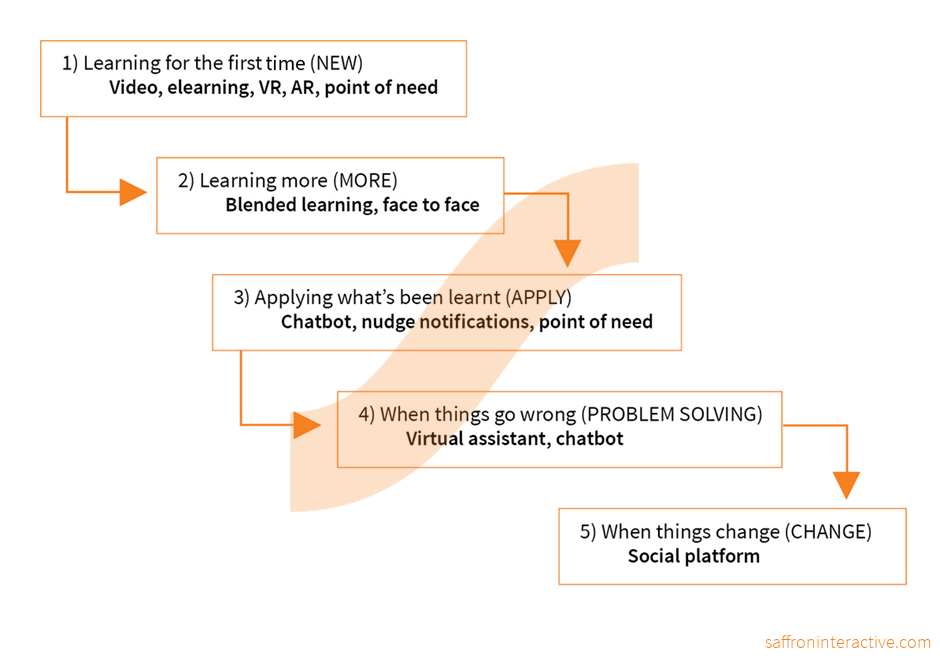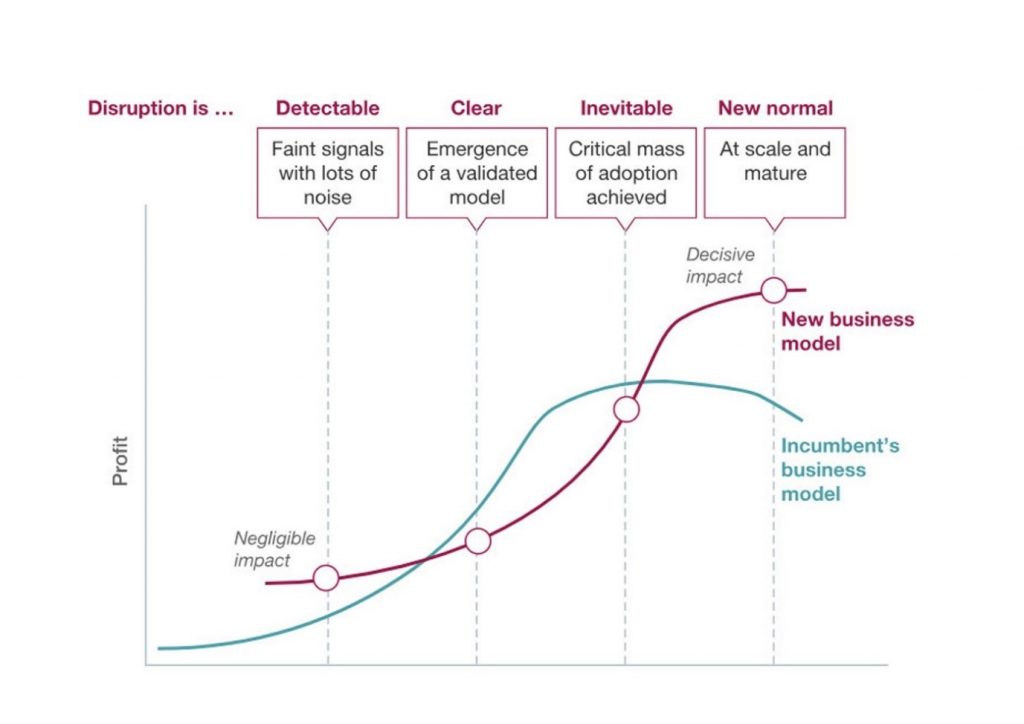Take a moment to think about how digital disruption is affecting the business you’re working in. Not you personally or your department, but your actual business or industry.
Requires a bit of thought, doesn’t it?
It’s not easy to analyse all the moving parts. The relentless pace of change means that patterns, consequences, outcomes and solutions are difficult to articulate, let alone solve.
This is the quandary that most senior leaders are in at the moment. They don’t know how to respond to the new world order, and if they did, is the business able to change quick enough? Are there enough people with the right skill set and leadership capability to execute the target operating model?
Digital disruption is really causing a state of confusion. Add to that confusion an uncertain political and economic climate and it becomes even harder to decipher a clear vision.
This is therefore the perfect time for HR and L&D to make an impact. Because all the issues are about people – the skills gap, productivity, engagement, performance. So as an L&D professional, how do you create a learning strategy, culture and strategic partnership with the business; and one that is agile enough to deal with constant change?
Well, there is an approach that may work for you, but first it’s important to understand the external factors that are at play and what your leaders are up against, in order to understand how agile you will need to be, as will your approach to learning within the organisation.
The pace of agile tech disruption and consumer adoption
For the first time, it’s not the big companies that are driving new ideas and imposing their brands on us. Rather, it’s us as consumers that are choosing new trends and making or breaking companies.
The rapid consumer adoption of new technologies is driving unprecedented business growth, as the chart below shows:
It took Google eight years to reach a valuation of $1 billion. It took Uber only four. And Xiaomi, a name many in the West haven’t even heard of, took only two. Xiaomi is a Chinese electronics company that makes smartphones, mobile apps, laptops, and IoT devices. In fact, it’s now the world’s 4th largest smartphone manufacturer, and its valuation stands at around $46 billion. That’s an incredibly rapid rise, one that wouldn’t have been possible in the pre-digital world.
And whilst the value of organisations is soaring quickly, the price of new technology is going in the other direction, the second factor in digital disruption.
The cost of advanced technology is plummeting
It’s becoming affordable for everyone, and businesses can change rapidly without incurring the kind of capex that would have previously been prohibitive.
The price of industrial robots is now cheaper than hiring a person – and potentially more reliable! It wasn’t that long ago that the Genome Project started trying to trace the genes in our DNA through years of work. Now we can order DNA testing kits online.
And the third thing fuelling the rapid pace of disruption is the fact that distribution costs are in many cases, a thing of the past.
Digital distribution costs almost nothing
The distribution of digital content and products costs more-or-less nothing, increasing the scale and pace of adoption even further. Digital distribution is gaining pace. Even B2B buyers make around half of their purchases online, without the intervention of a sales rep. This change in buying behaviour is obviously affecting brick-and-mortar retailers but also reshaping the role of salespeople.
Just to put it in context, in less than 20 years since going public, Amazon is today the eighth largest employer in the US.
So how are business leaders responding?
In research recently compiled by Deloitte, which interviewed 1600 C-level executives from all over the globe, have a guess at what percentage believed that they’re doing all they can to build the right kind of workforce for the digital age.
What percentage of C-level executives believe they're doing all they can to build the right kind of workforce for the digital age?
86%
That’s a clear majority, and a good response for us in L&D and HR, showing that business leaders are willing to support our endeavours.
Given that figure, then, what percentage do you think regard talent and HR issues as a high priority?
What percentage of C-level executives regard talent and HR issues as a high priority?
20%
That result, from the same group of people seems to be contradictory with the previous statistic, and further, only 14% of business leaders are highly confident in their ability to harness the changes associated with Industry 4.0. That in itself is quite startling, and only 25% are highly confident that their workforce has the skill sets needed for the future.
These contradictory statistics show that whilst business leaders understand the threats, there is little confidence in being able to frame a response and execute on priorities and opportunities.
The key reason for emphasising this analysis is that if L&D sit back expecting the business to have a response, vision and direction, it appears that this may not be very forthcoming.

Radical change is needed
It’s clear that the current approach isn’t optimal. 57% of jobs are potentially set to be automated within 5 years and the useful half-life of a skill has dropped from an average of 30 years to 6.
In the future, every company will be a technology company. How can we build a learning framework that is agile enough, that can respond to business issues at a time of the greatest change we’ve ever seen – one that can change behaviours and secure adoption at an increasing pace? Given the business’ confused response, I would advocate L&D and H&R paving the way.
The first step is knowing where the business is in the wider context. Is it an incumbent or a disruptor? Who are its competitors – traditional and new threats? There will be pockets of people that are forward-looking and have worked out where the business needs to be. Tap into these people and ask them what they need their people to be able to do for them to succeed. Then, make them accountable for people issues as L&D and HR can only be a trusted advisor, a facilitator to challenge, execute and enable. The business must take ownership – ownership in identifying needs, following through on initiatives and measuring results.
'In the future, every company will be a technology company.'
Strategise, strategise, strategise
A modern learning strategy needs to:
- Start with business performance
- Plan for disruption
- Make learning continuous, personalised, at the point of need and in the workflow
- Build essential skills
- Mine data
Here’s how it can do so.
Business performance and planning for disruption
Every business is on a disruption curve, indicating how it is responding to disruption at certain stages of its development. It’s important to know whether your business is an incumbent or a disruptor and where they are on this S curve, because different parts of the curve present different challenges.
Knowing where you lie on the curve allows you to wrap your learning strategy around these challenges, and also to predict what your pain points will be in the next few years and what kind of resistance or barriers you can expect internally.
The above model is from McKinsey, and I recommend you try and situate your own business on it. Are you in a myopic phase, for example, where things are going swimmingly, and the business is avoiding pain to the extent that inertia creeps in? Or are you instead a disruptor, where the opposite is likely to be taking place?
Try taking this model to your stakeholders, asking them to plot where they think the business and its competitors are and then start the conversation about what the actual needs of the business will be in the next 6, 12, 18 and 24 months.
For even more insight, try supplementing this with a survey of a representative group of learners in the part of the business you’re trying to reach. This helps situate the business, transfers accountability for people issues to it and allows learners to determine what they need to fulfil the business vision.
Continuous learning
Following on from those discussions with learners, your strategy needs to consider how to make learning continuous. I see organisations with great induction plans and executive or high potential learning, but somehow everyone in the middle is ignored so that the greatest mass gets the least attention.
This is the type of deficiency your strategy needs to address, for instance by targeting that middle ground, or by creating smaller, more personalised programs. These can be more adaptable and effective in times of rapid change, such as the quick adoption of new systems and processes.
You can also include new digital learning technology that keeps up with change and delivers learning at the point of need. Some of the latest performance support tools we have developed, such as Saffron eaSe, sit in the background but can recognise exactly where the user is in any system or desktop app to provide context-sensitive help. These tools can help extend the learning process and take some of the burden off pre-emptive training.
Point-of-need learning can bring the kind of technology consumers are used to adopting into your learning strategy – on-demand, personalised, in the background. They help clear head space for learners to be more productive and creative, and nurture critical analysis rather than learning by rote. All the more important given the dropping half-life of skills.
The new wave of digital learning also helps generate and track data, the great resource of the digital age and one that you should be using.
Data is your biggest differentiator
I constantly hear from L&D “We don’t have data” or “we’re not allowed to use it”, or “GDPR is getting in the way”. The much more likely reason is that people just don’t know how to use it. Indeed, as little as 18% of learning professionals have skills in data analytics.
We’re currently working with a data science company, and have managed to source data from their LMS, from appraisal systems, from assessments, from business KPIs, from HR databases… the list goes on.
This data gives the client insight into not only the current capabilities of learners, but also what kind of people will be successful now and their attributes; what will take them into the future and who will be the next generation of leaders.
You need to find the data in your business, because it allows you to make the business sit up and put the HR agenda back into the Boardroom.
A framework for learning
So how can you draw all these strategic considerations together into one structural framework that accompanies the learner throughout their whole learning journey? One approach is to use the following framework based upon Mosher and Gottfredson’s Five Moments of Need:

If you can use the disruptor curve context, business performance focus, continuous learning prioritisation and data discernments together with learning moments of need, then your learning strategy will get ahead of the pack.
While it might seem like a race, it’s an iterative cycle of continuous improvement. So get ready for the marathon but start now – or get left behind!
We’ve got something to help with that…









